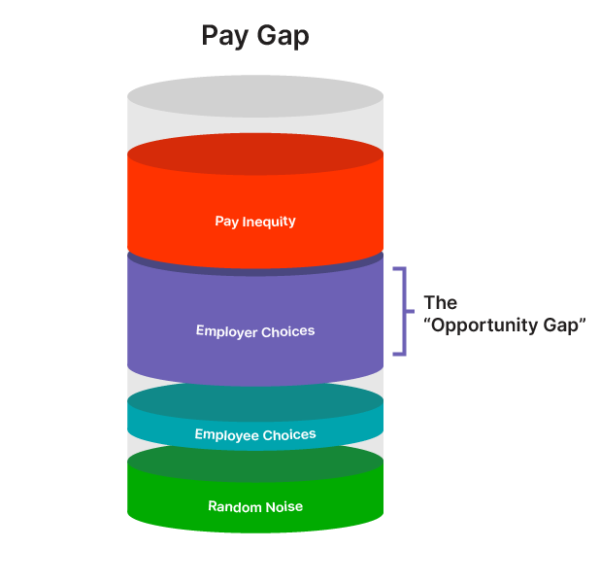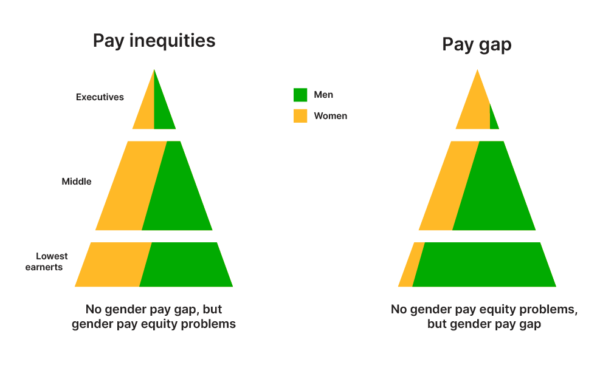It’s a common misconception that if a company achieves “100% pay equity” for gender, it means that they’ve closed their gender “pay gap.” That’s not the case because “pay gaps” are not the same as “pay inequities.” However, they are interrelated and it’s critical for companies to measure and take action on both. So, what’s the difference? And, what is the relationship between the pay gap and pay equity?
First, let’s define each. Then we’ll discuss how pay equity and pay gaps interact — and how companies can address both.
What is pay equity?
Pay equity is compensating people performing equal, substantially similar, or comparable work in a way that is not based on workers’ gender or other protected category characteristic (like race or ethnicity), but instead may be explained by neutral, job-related factors that differentiate workers’ skills, effort, accountability and working conditions. In the case of gender, for example, this is measured by statistically evaluating compensation by groups of similar workers (e.g. engineers) and ruling out that the distribution of compensation for female workers is different than that of male workers, after adjusting for justifiable factors like experience, seniority, or location. In the U.S., pay equity is most commonly analyzed on the basis of gender and/or race or ethnicity, but it can be compared across any demographic including: age, sexual orientation, disability, caregiving status, and more.
Confusingly, pay equity is sometimes referred to as the “equal pay gap” but usually when people refer to “the pay gap,” they are referring to the median, unadjusted pay gap — we’ll define that in the next section.
What is the pay gap?
The “pay gap” (also known as the “wage gap”) is a measure of overall differences in mean or median earnings between two populations. For example, the gender pay gap is the difference between what men as a group earn on average vs. what women as a group earn on average, within a population. The most recently measured national gender pay gap in the United States found that women earn only 82 cents for every $1 men earn when comparing all women to all men.
The pay gap usually refers to the median, unadjusted/uncontrolled pay gap. The pay gap may be “adjusted” when the gap accounts for differences between men and women based on measurable characteristics like tenure or years of experience. Some regard all-up pay gap information as a way to tell how balanced companies are at the top, where there are typically fewer but higher paid individuals, versus at the bottom, where there tend to be more people but at lower pay.
“Median pay data shows us, quite literally, how companies assign value to their employees through the roles they inhabit and the pay they receive.”
– Natasha Lamb, Managing Partner, Arjuna Capital
Much of the national gender pay gap is due to the fact that women overall work lower-paying jobs than men and are less represented in the highest levels of business — which is due to a mix of root causes, including unequal access to jobs, promotions, and opportunities to collaborate on high-profile projects, pay differentials across gendered job functions (i.e., IT roles, which are traditionally male-dominated, are often paid more than HR roles, which are traditionally female-dominated), and the negative impact on salaries, advancement, and tenure due to factors such as caregiving responsibilities.
What is the relationship between the pay gap and pay equity?

Pay equity is often the biggest explainer of the pay gap, and it is important to address pay equity issues up front. The second biggest explainer of the pay gap is what we refer to as “opportunity gaps” (i.e., disproportionate access to opportunities such as jobs, promotions, and other forms of advancement).
A company can achieve 100% gender pay equity in role-to-role comparisons, but still have a persistent “all up” gender pay gap. How? In the case of gender, for example, it would mean that men and women who do the same or similar roles get paid equally after adjusting for neutral, job-related factors, but that overall, men in the organization earn more on average than women as a group. This could be because women in the company are not being represented at the same level as men in higher paying positions (which has root structural causes in inequitable hiring, promotions, and retention).
How to address both pay inequities and the pay gap
Pay inequity is often the largest driver of a company’s pay gap — and it should be the easiest and most natural place to start for most organizations when it comes to closing the pay gap. That’s because pay equity is entirely within a company’s control to solve through statistical analysis and remediation (as long as they have the budget to increase compensation for underpaid employees).
Addressing the other components of the pay gap within the employer’s control requires companies to address opportunity equity, meaning that employees have equivalent access to opportunities for employment, advancement, and development — regardless of gender, race, or other protected category status. To improve opportunity equity, companies must analyze their recruiting, hiring, onboarding, and promotion policies and ensure they are consistently, objectively, fairly, and equitably enforced for all employees and job candidates.
Syndio’s Workplace Equity Platform enables organizations to forge a comprehensive approach to solving root causes of both pay inequities and opportunity inequities. This purpose-built technology helps companies analyze, resolve, and prevent pay inequities more quickly and efficiently, as well as using analysis, benchmarks, and data visualizations to measure equity in opportunities and set realistic representation goals.
Why does addressing workplace inequities matter?
If left unaddressed, pay inequities and pay gaps often compound over time, creating large disparities in lifetime earnings and wealth accumulation for underrepresented groups. According to the National Women’s Law Center research on the lifetime wage gap, women lose $406,280 over the course of a 40-year career, while for Black women the lifetime earning losses are nearly a million ($964,400). While examining EEO-1 data from 2009-2018, Syndio’s research team found that white men in the U.S. are 9.2 times more likely to be in leadership positions than Black women, after controlling for qualified, available talent.
Workplace inequities come with the risk of lawsuits, brand damage, employee attrition, decreased productivity, and, increasingly, investor scrutiny and demands for transparency. But solving these disparities is also a matter of doing the right thing to create more equitable workplaces — and a more fair society.
Syndio’s entire mission is to help companies eradicate workplace inequities and ensure every employee is valued for who they are and what they contribute to their company’s success. We have the tools and expertise to help your company tackle pay and opportunity inequities so you can show measurable progress. Want to see how it all works?



